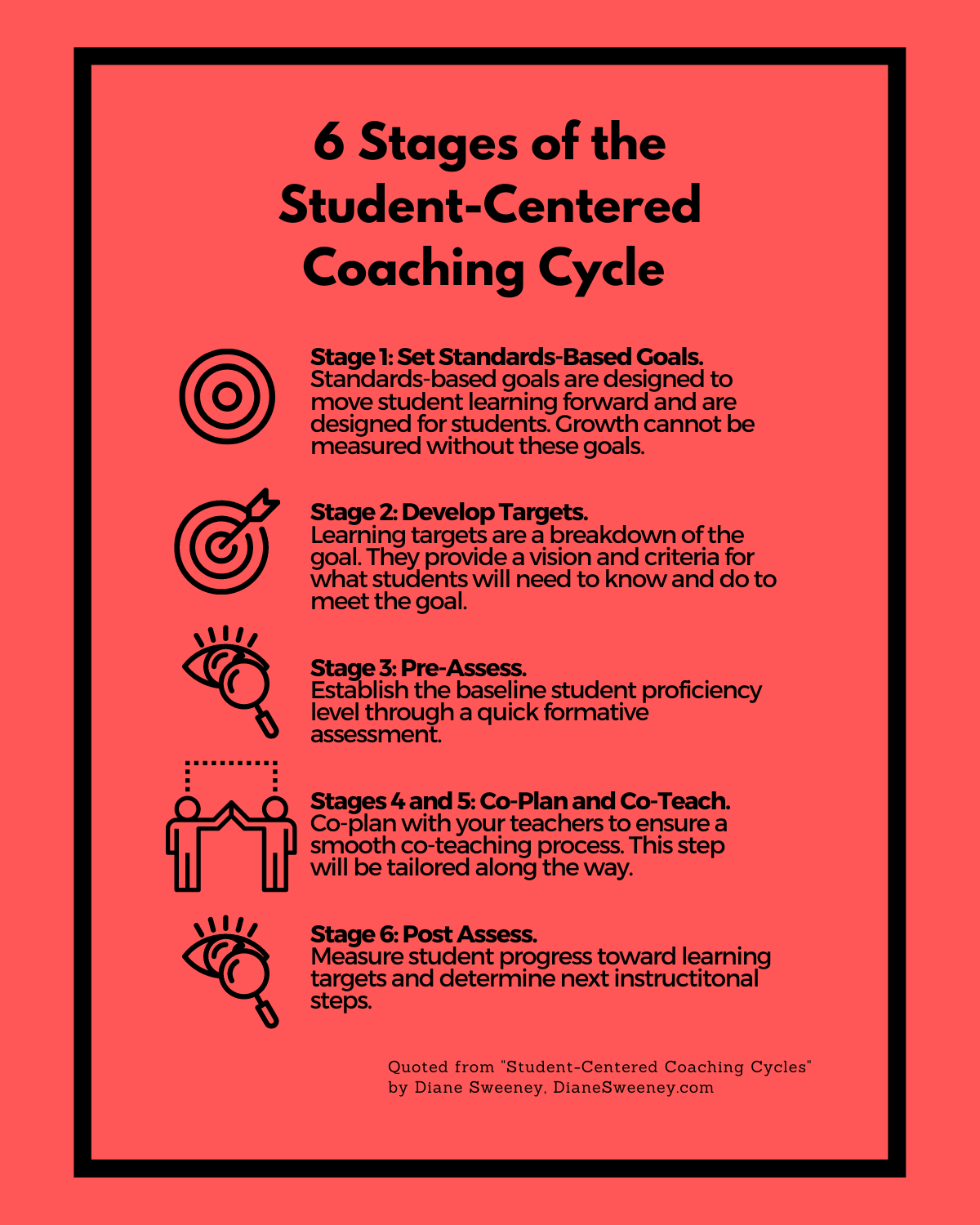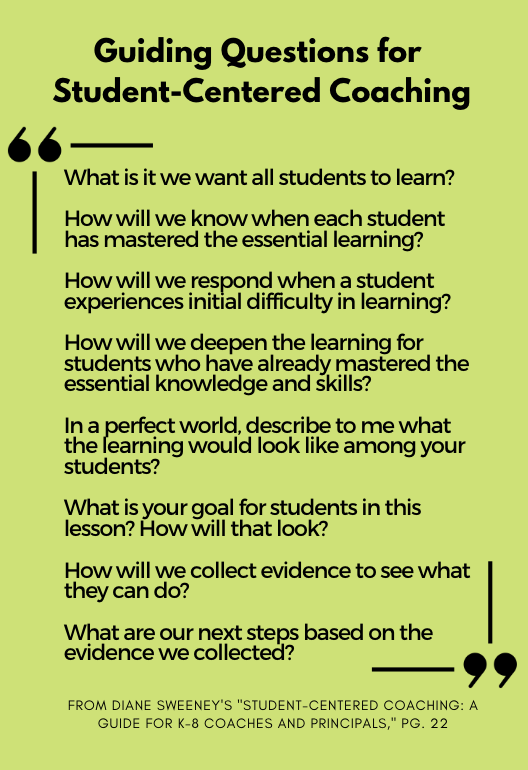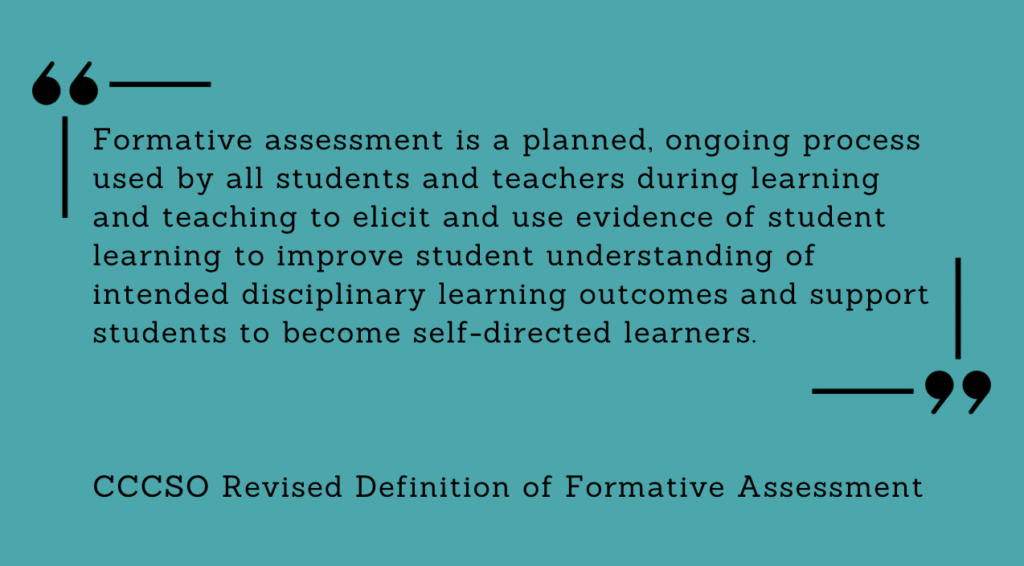If you’ve been working in education in a position that includes coaching, you might be familiar with Research-Led Coaching (Jim Knight), Cognitive Coaching (Elena Aguilar), Bambrick-Santoyo’s Six Step Model, and other coaching models. Today, we’ll explore Student-Centered Coaching (Diane Sweeney). There’s a LOT to unpack in Sweeney’s model, so we’ll focus on defining the model and outlining the coaching cycle. Then, in part two, we’ll go over getting started with student-centered coaching. Are you excited? I am! Before we dive in, here is some research on the effectiveness of student-centered coaching that you might find interesting.
What Is Student-Centered Coaching?
Sweeney explains that coaching should be less centered around “what the teacher is doing or not doing,” executing a program/curriculum, and the coach as an “expert” holding the teacher accountable. Instead, she suggests that the focus be placed on the program/curriculum as a tool, collaboration in setting data-informed learning goals, and the coach as a teacher partner. Shifting the focus to designing instruction for students based on discussion, reflection, data, and standards means shifting the focus off of the teacher and teaching techniques.

This shift sets teachers and coaches up for success by removing some of the roadblocks that come with directly challenging the beliefs and practices of teachers. A teacher-centered approach might look like convincing a teacher to try out a specific method or strategy that they aren’t currently using as suggested by the coach. A student-centered approach would look more like the teacher and coach discussing student learning data, agreeing on and setting the goals, collecting more evidence, and making decisions together to adjust instruction based on the evidence. That said, discussing and determining what can be used as student evidence for goal setting is a big part of the process, so formative assessment is at the very heart of this coaching model.
What’s the Role of Student Evidence in Student-Centered Coaching?
In order to adjust instruction to better meet the needs of students and set goals, teachers must identify 1) what students already know and can do, 2) the standards that students need to know, and 3) how to instruct to meet these “need to knows.” Using formative assessment to draw these conclusions requires teachers to know the curricular standards, be able to implement formative assessments, and be able to execute varied instructional strategies.
One thing that stands out to me about this model is the correlation between formative assessment data and the consequent natural differentiation of coaching for each teacher. When decisions are made collaboratively about instructional goals based on data, the coaching goals can be clear, differentiated for each teacher, and less likely to meet with resistance. Teachers want the focus to be on the students, so why not base our discussions on what data shows students need?
What Are the Stages in the Coaching Cycle?
Sweeney suggests six stages for a student-centered coaching cycle to “provide a framework for designing ongoing and in-depth work with teachers.”

Stage 1: Set Standards-Based Goals. Standards-based goals are designed to move student learning forward and are designed for students. Growth cannot be measured without these goals.
Stage 2: Develop Targets. Learning targets are a breakdown of the goal. They provide a vision and criteria for what students will need to know and do to meet the goal.
Stage 3: Pre-Assess. Establisth the baseline student proficiency level through a quick formative assessment.
Stages 4 and 5: Co-Plan and Co-Teach. Co-plan with your teachers to ensure a smooth co-teaching process. This step will be tailored along the way.
Stage 6: Post Assess. Measure student progress toward learning targets and determine next instructitonal steps.
Quoted from “Student-Centered Coaching Cycles,” by Diane Sweeney, DianeSweeney.com
When moving through this coaching cycle, it’s important to document the process through note-taking. Sweeney provides a Results-Based Coaching Tool for small groups and a Student Evidence Note Catcher on her website. And, even though this book has been replaced by “The Essential Guide for Student-Centered Coaching (2020),” I find her guiding questions for student-centered coaching in “Student-Centered Coaching: A Guide for K-8 Principals (2010)” (22) to be helpful and relevant.

What do you think of this model? Is it the same or different from how you or your school approaches coaching? How would you go about implementing something like this? If you’re interested in knowing more, check out “The Essential Guide for Student-Centered Coaching,” by Diane Sweeney. As I mentioned early, it’s the 2020 replacement for “Student-Centered Coaching: A Guide for K-8 Coaches and Principals,” which was published in 2010. Leave a comment to share your thoughts. Stay tuned for Part Two: Getting Started with a Student-Centered Coaching Model!




2 comments
Is there a part 2?
Hi Victoria! Here is part 2! I also added it to the end of the post in case others are wondering. Thanks for reading!